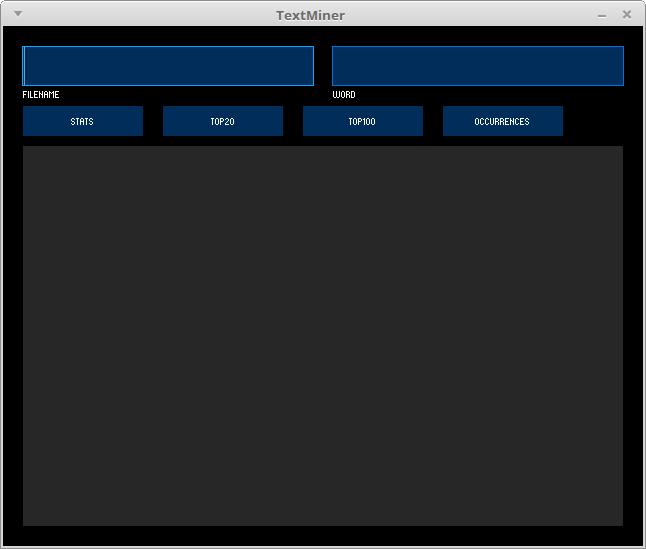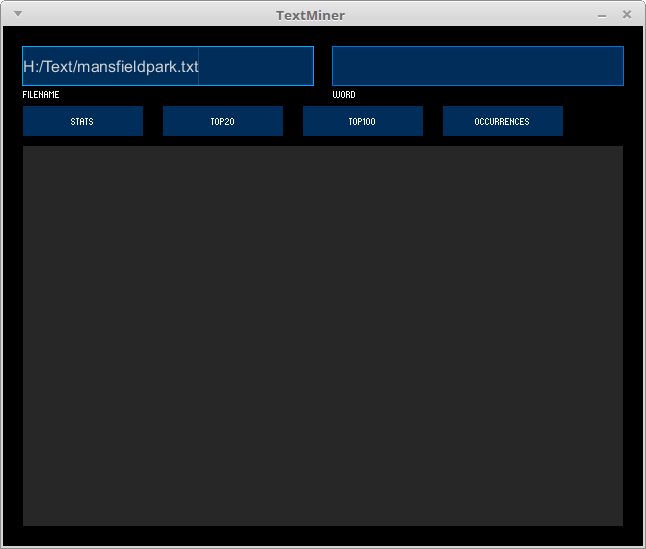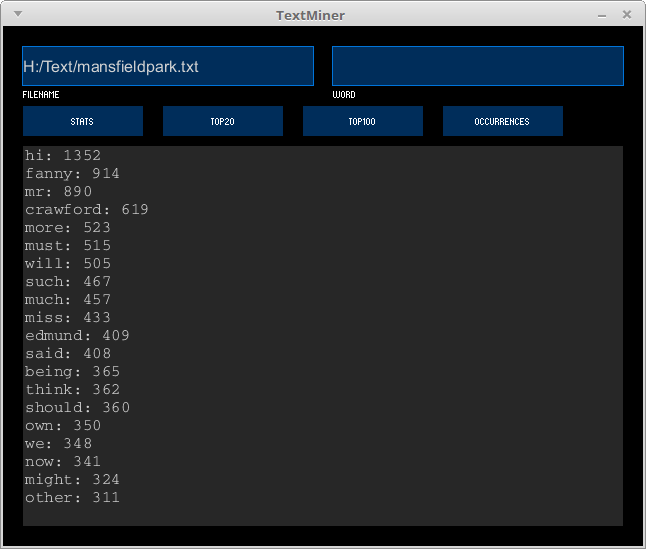Learning goals
- Find word usage patterns in a text
- Create and test a hypothesis using automated text analysis
What to do
Read the Text mining section.
Then, create and test a hypothesis as described in the Experiment section. Make sure that you create a document in your Google drive folder as described.
Text mining
Copy and paste the following code into an empty Processing sketch:
Run the program. You should see the following window (click for full size):
This program allows you to do some very basic analysis of word usage in a text. Start by downloading a text from the Project Gutenberg website, which is a repository of public domain books. Make sure that you choose the Plain Text UTF-8 download. For example, I chose Mansfield Park by Jane Austen. When you save the text, save it using a folder and filename you will remember: I saved files in a Text folder in my H: drive, and saved the file as mansfieldpark.txt.
Start by entering the filename of the text you want to analyze in the FILENAME box (click for full size):
Once you have entered the filename, you can click one of the buttons to analyze the text:
STATSshows you how many words are in the textTOP20shows you the 20 most-frequently occurring wordsTOP100shows you the 100 most-frequently occurring wordsOCCURRENCESshows you the number of times the word you enter in theWORDtextbox occurs in the text
For example, here is what is shown when clicking TOP20 for Mansfield Park:
Note that there are a few quirks:
- The program assumes that any word ending in “ies”, “es”, or “s” is a plural, and attempts to convert it to singular; this conversion may not be correct for some words
- The program ignores “boring” words: these are defined in the program’s
setupfunction; you may want to add additional boring words to the list
Experiment
Think of a hypothesis about literary works available from Project Gutenberg that can be tested by analyzing word frequencies.
Here is an example:
Dickens’s later novels are “darker” than his earlier novels, so words evoking darkness or sadness should be relatively more frequent in his later works that his earlier works
Let’s test this hypothesis by comparing word usage in The Pickwick Papers (1836) with Great Expectations (1860).
First, these are the total word counts for each novel:
Book Word count The Pickwick Papers 301,948 Great Expectations 187,364
Let’s look for occurrences of the words “dark” and “sad”/”sadness”. Note that we don’t want to compare the absolute numbers of occurrences, since the two novels have different numbers of words. Instead, we’ll compare the occurrence frequency of the words we’re interested in by dividing the occurrence count by the total number of words.
Book “Dark” “Dark” freq. “Sad” or “sadness” “Sad” or “sadness” freq. The Pickwick Papers 64 .000211 7 .000023 Great Expectations 68 .000362 5 .000026
The word “dark” appears much more frequently in Great Expectations than The Pickwick Papers, supporting our hypothesis. The words “sad” and “sadness” occur with about the same frequency in each novel.
Create a document called Text mining experiment in your shared Google Drive folder. State your hypothesis and record data to test your hypothesis. Finally, analyze the data and state whether or not it supports your hypothesis.



